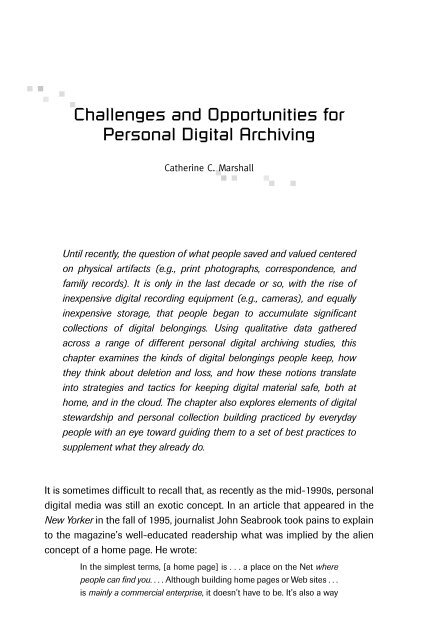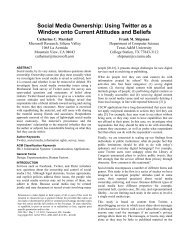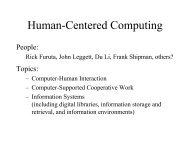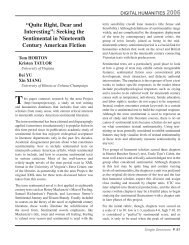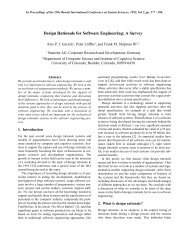Challenges and Opportunities for Personal Digital Archiving
Challenges and Opportunities for Personal Digital Archiving
Challenges and Opportunities for Personal Digital Archiving
You also want an ePaper? Increase the reach of your titles
YUMPU automatically turns print PDFs into web optimized ePapers that Google loves.
XueSemantic Role Labeling of Chinese Predicatesargument may not always be realized, <strong>and</strong> when it is, it may not always be realizedin the same syntactic position as a result of syntactic alternations (Levin 1993), etc.. Inaddition, different senses of a verb take different sets of arguments that demonstratedifferent syntactic patterns. Thus, predicate-argument structure analysis at this levelrepresents a crucial leap towards proper representation of semantic structure fromthe syntactic structure. The PropBank (Palmer, Gildea, <strong>and</strong> Kingsbury 2005), whichannotates the semantic roles <strong>for</strong> every verb in the Penn Treebank (Marcus, Santorini, <strong>and</strong>Marcinkiewicz 1993), is also particularly amenable to statistical <strong>and</strong> machine-learningapproaches to Semantic Role Labeling. As a result, since its completion, it has fueledthe development of a large number of Semantic Role Labeling systems (Gildea <strong>and</strong>Palmer 2002; Hacioglu et al. 2004; Pradhan et al. 2004; Xue <strong>and</strong> Palmer 2004; Toutanova,Haghighi, <strong>and</strong> Manning 2005; Punyakanok, Roth, <strong>and</strong> Yih 2005a). It has also been usedas training <strong>and</strong> test material <strong>for</strong> the shared task of the CoNLL competition <strong>for</strong> twoconsecutive years (Carreras <strong>and</strong> Màrquez 2004b, 2005).In this article, we report experiments on the Semantic Role Labeling of Chinesepredicates <strong>for</strong> both verbs <strong>and</strong> their nominalizations, exploiting two recently completedcorpora, the Chinese Proposition Bank (Xue <strong>and</strong> Palmer 2003), a corpus that annotatesthe predicate-argument structure of Chinese verbs, <strong>and</strong> the Chinese Nombank (Xue2006a), a companion corpus that annotates the predicate-argument structure of nominalizedpredicates in Chinese. Both corpora are built on top of the Chinese Treebank(Xue et al. 2005), in the sense that the semantic role labels are assigned to constituentsin the parse tree. Research on Chinese Semantic Role Labeling is still at its infancy <strong>and</strong>the only previous work close to ours is by Sun <strong>and</strong> Jurafsky (2004) who did preliminarywork on Chinese semantic role labeling using 10 selected verbs.3
96 I, <strong>Digital</strong>explore. While it would be most satisfying to offer a system architecture, amechanism, a representation, or even a coherent story that addresses digitalarchiving with a holistic solution, it would be misleading to do so. So instead,I will frame the problem by introducing three overarching questions thathave arisen from the changes that have occurred since we have grown intodigital beings with significant things to archive:••What does a typical personal digital collection contain?What is the technological basis <strong>for</strong> storing, maintaining, <strong>and</strong>preserving this collection?• Which stewardship practices do people bring to bear on the problem<strong>and</strong> which best practices should they be taught to supplementexisting practices?With each of these questions, I will discuss particular elements of anadaptive solution—one that does not commit to a specific path of technologyadoption, one that does not assume the growth of a specific media type (e.g.,digital video), or presuppose drastic changes in human behavior.Figure 1 adapts the digital library framework presented in Going <strong>Digital</strong>:A Look at Assumptions Underlying <strong>Digital</strong> Libraries to structure these threefundamental questions as arising from the interactions between digital stuff,technology, <strong>and</strong> human activity. 8 Given this framework, any personal digitalarchiving ef<strong>for</strong>t will necessarily involve a digital collection (or more accurately,an accumulation of digital belongings that neither has the distinct boundaries,nor the acquisition policies of a more <strong>for</strong>mal collection); technology <strong>for</strong>storing <strong>and</strong> sustaining digital belongings; <strong>and</strong> digital stewardship practices.digitalcontentstewardshippracticespersonal archivingtechnologyFigure 1. A personal digital archiving framework.
<strong>Challenges</strong> <strong>and</strong> <strong>Opportunities</strong> <strong>for</strong> <strong>Personal</strong> <strong>Digital</strong> <strong>Archiving</strong> 97In other words, personal digital archiving will boil down to nothingmore profound than deciding what we should keep, how <strong>and</strong> where weshould store it, <strong>and</strong> what sorts of work people will have to do to keep theirdigital collections alive. At first blush, the answers seem as simple as thequestions. As a strawman collection policy, we will keep everything. A securecentral repository containing self-describing digital objects protected bysophisticated access policies will provide people with a facility very closeto a digital safety deposit box that uses the emulative principles thatRothenberg—<strong>and</strong> later Henry Gladney <strong>and</strong> Raymond Lorie—had in mind. 9Finally, personal digital stewardship can be modeled after the best practiceswe have developed to keep important individual collections alive when theyare donated to archives, museums, <strong>and</strong> libraries. 10We can dust our h<strong>and</strong>s off <strong>and</strong> go home, having assigned the questionof best practices to professional archivists, the storage question to computerscientists, <strong>and</strong> having punted on the collection question entirely. Or can we?Let us look at each question in turn; then let us ask ourselves “Is that allthere is?”What Is in a <strong>Personal</strong> <strong>Digital</strong> Collection?Certainly the most basic question about personal collections centers on whatwe should keep.It is very tempting to throw up our h<strong>and</strong>s <strong>and</strong> say, “Storage is cheap. Isthere any reason not to keep it all?” Even if our personal digital belongingsare accumulating at a truly breathtaking rate, sharp reductions in storagecost make it unlikely that we can break the storage bank. Although we haveall had the experience of filling up our hard drives, we usually regard thatoccurrence as a signal of obsolescence, as a warning sign that it is time tobuy a new computer, or at least install a new, more capacious, disk drive.And why not keep everything? There are plenty of reasons to do so.First—<strong>and</strong> most importantly—it is very difficult to assess an item’s or mediatype’s future worth many years be<strong>for</strong>e the value is proven. Although weare confident that some digital assets are indeed worth keeping—the greatAmerican novel we have begun writing (<strong>and</strong> perhaps have returned to atdifferent times through our adult years); our wedding photos; our children’sgraduation videos—in short, the documentation of life’s milestones <strong>and</strong>
<strong>Challenges</strong> <strong>and</strong> <strong>Opportunities</strong> <strong>for</strong> <strong>Personal</strong> <strong>Digital</strong> <strong>Archiving</strong> 99not be so literal. Let us say that a “keep everything” strategy is logisticallypossible <strong>and</strong> results in an indefinitely large store of all of your digital stuff<strong>for</strong> all time. If people are left to their own devices, this mode of accumulationseems to reflect the natural order of things.It is also important to realize that deletion comes with an associated cost.Why fight against intellectual gravity? After all, deletion is difficult, thanklesswork; it is cognitively taxing to decide whether to keep something or toss it<strong>and</strong> the immediate return is minimal. And as yet, there is no Nobel Prize orOscar awarded <strong>for</strong> maintaining a neat, well-pruned file system.Again, in practice, deletion is a far less systematic process than onewould hope <strong>for</strong> or even imagine. It is far more likely that when they are doingsomething else, people will notice an unfamiliar file name, or encounter anitem that seems to be of no persistent value, or assess a piece of email asspam, irrelevant, or no longer interesting, <strong>and</strong> delete it on the spot (oftenwithout even looking at it). Symptomatic of this behavior, during interviews,participants will spontaneously delete a few files as a symbolic act, declaringtheir distaste <strong>for</strong> clutter. However, this unpremeditated act does not meanthat a participant is committed to spending the next week sorting throughher files. For example, in a 2005 study, as we watched a couple going throughtheir hard drive, one of them said to the other: “I don’t know what that is. Youmight as well delete it as far as I’m concerned.” In other words, there is noneed to look; it is unfamiliar, so it is unlikely to be valuable. In spite of the factthat there are probably many such low-value files stored on the computer,the participant somewhat arbitrarily deletes the one that is currently in view,frequently vowing to go after more such files soon.During the same study, we were observing a participant go through afolder during an exercise in which we asked people to look <strong>for</strong> the oldestpersonal file stored on their hard drives. The participant in questionencountered a c<strong>and</strong>idate file, did not immediately recognize what it was,opened it, <strong>and</strong> remembered, thereby setting off a longer reflection aboutdeletion <strong>and</strong> decision:“This could’ve been a seminar or something. Now I remember—[thefile’s contents describe] what was going to be in the seminar <strong>and</strong>I didn’t go to it. Wow. Yeah. I haven’t looked at this stuff in a longtime. I mean, it would be sort of interesting to get the pop-up, make adecision on it, <strong>and</strong> then let it go . . . [in the future] I will become a lean,mean organizing machine.”
100 I, <strong>Digital</strong>Yet he did not delete this particular file once he remembered what it was,nor did he delete any of the others he assessed as clutter.In another study—this time focused on researchers <strong>and</strong> their personalscholarly materials—one participant was going through his files as I watched.He found a directory on the server replete with files he decided were nolonger valuable. As I continued to observe him, the researcher began to deletefiles without even looking at their contents, only the file names <strong>and</strong> dates.Sometimes he did not remember their purpose, <strong>and</strong> sometimes he did:“The server also stores tons of stuff from when I was working on[project x]. We stored all kinds of shared stuff out there so we couldaccess it. And I need to go through <strong>and</strong> clean that up because there’sgobs of junk out there that should just get deleted . . .”[I ask what a particular file contains.]“I don’t remember. That’s why it should probably all be deleted. . . .These I think are datasets from various runs. Yeah. This is—no, this isinstallation files. For various versions of [the software developed <strong>for</strong>project x]. All this should go. Yeah. These are installation files. Theyshould all go away. They’re useless.”[He begins deleting files.]“None of these things mean anything. Except <strong>for</strong> this. But the lineanalyzer stuff. I’ll never use it. So let’s just get rid of that. This stuffshould go away. This looks like an archive of the [final version of aconference paper].” 12Most experienced computer users realize that they delete items in asomewhat arbitrary manner. What varies is whether they plan to somedaybecome more methodical in their curatorial ef<strong>for</strong>ts, or whether they acceptthe vagaries of their own stewardship practices—whether they plan tobecome lean, clean, organizing machines, or whether they see the endeavoras more or less hopeless.During another study (Marshall et al., 2006), a participant acknowledgedthat his digital stewardship practices were more or less arbitrary. When Iasked him whether he ever got rid of digital stuff, he said:“Yes, but not in any systematic manner. . . . It’s more like, I have thingslittering the desktop <strong>and</strong> at some point it becomes unnavigable . . . .A bunch of [the files] would get tossed out. A bunch of them wouldget put in some semblance of order on the hard drive. And some of
<strong>Challenges</strong> <strong>and</strong> <strong>Opportunities</strong> <strong>for</strong> <strong>Personal</strong> <strong>Digital</strong> <strong>Archiving</strong> 101them would go to various miscellaneous nooks <strong>and</strong> corners, never tobe seen again.”Another participant, when asked how his files were organized,confessed:“I keep telling myself that maybe one day I’ll basically do the computerequivalent of spring cleaning. I’ll just find all these scattered directories<strong>and</strong> files <strong>and</strong> sort of clean them, create a fresh hierarchy of ‘here aremy pictures,’ ‘here are my movies,’ ‘here are my documents,’ ‘here ismy music’ <strong>and</strong> get them all cleanly laid out along those lines. And I justnever seem to find the time.” 13There is another, more principled, reason to keep everything. Thisperspective stems from the idea that the computer will eventually serve asthe ultimate memory prosthesis. 14 In other words, the computer’s storageis equated with the capacity of human memory, <strong>and</strong> by extension, deletingcorresponds to <strong>for</strong>getting. 15 Thus, if we adopt the memory prosthesisperspective, deleting files means that useful context is eliminated, <strong>and</strong> welose the ability <strong>for</strong> every digital item to act as an index to the other digitalitems that occurred around that time, in that place, or with those people.Deleting files is tantamount to deliberately making a hole in one’s memories,inducing amnesia, <strong>and</strong> potentially reducing the prosthetic power of thecomputer. But the advantage of keeping everything comes at a price.Recall the reasons we would keep everything:•••••It is difficult to assess value in advance;Keeping everything aligns well with current practice;Deletion is itself a cognitively dem<strong>and</strong>ing exercise;People are seldom methodical about culling their files, so why eventry; <strong>and</strong>A full chronological <strong>and</strong> contextual record is essential <strong>for</strong> usingone’s archives as a memory prosthesis.Just because it is easier keep to everything than to cull it, does this meanthat there is no virtue in the natural falling away of digital belongings throughtime’s gradual erosion? As we examine what people do, a puzzling patternemerges: people seem to be relying on disk crashes, technology failure, <strong>and</strong>periodic obsolescence as a way of pruning their collections. It is not that
102 I, <strong>Digital</strong>loss does not bother them; it is rather that loss makes their collections moretractable. The accumulated weight of these digital belongings is swept away,so that they can focus their attention on the present. Three quotes fromseparate interviews conducted in the course of the study cited above confirmthat this is a common perspective:“You want to know the truth? If I blasted my 11,230 emails away, Iwouldn’t be that bad off probably. Because I’d be able to work on newones coming in.”“If my hard drive was gone, it really wouldn’t bother me all that much,because it’s not something I need, need. I just thought it would benice to keep in around in case I have another [school] assignmentjust like it.”“I mean, there’s plenty of stuff that I’ve lost that I thought used tomatter to me, but not so much. I used to be a real America Online chatguy back in high school. And I’d chat with people from all over theworld <strong>and</strong> one of the cool things is that your logs would get saved <strong>and</strong>I actually met one of my girlfriends online . . . I could literally go back ayear <strong>and</strong> just look at old chats that we would have. . . . I switched PCs<strong>and</strong> I just kind of <strong>for</strong>got to transfer those files over. Or maybe I wasn’table to. Maybe the <strong>for</strong>mats were incompatible with the new version. Idon’t remember what happened, but at this point, I’ve clearly learnednot to care. I mean, I thought I would’ve cared. It might’ve been niceif I still had them.” 16This cycle of accumulation <strong>and</strong> accidental lose may underlie thethous<strong>and</strong> logistical explanations that consumers offer <strong>for</strong> failing to back uptheir computers. In the end, people may be unhappy about data loss, but theyshrug it off, all too frequently saying exactly the same thing: “I mean, if wewould’ve had a fire, you just move on.” Of course, if you had as many fires ascomputer crashes, you would look <strong>for</strong> the arsonist among your friends <strong>and</strong>family members; you would not simply move on. But we can readily identifysome countervailing reasons why we would not keep everything. First <strong>and</strong><strong>for</strong>emost is that although storage is cheap, human attention is far less so.Furthermore, as we will see later in this chapter (<strong>and</strong> in other chapters of thisbook), stewardship is more than simply storing digital belongings once onreliable storage; stewardship requires continual attention to the items <strong>and</strong>media in a collection: Are the <strong>for</strong>mats still active? Is the storage mediumstill good <strong>and</strong> still up-to-date? Has virus protection successfully eliminated
<strong>Challenges</strong> <strong>and</strong> <strong>Opportunities</strong> <strong>for</strong> <strong>Personal</strong> <strong>Digital</strong> <strong>Archiving</strong> 103all threats? Keeping everything places an enormous tax on our stewardshipresources. Finally, even if we are careful not to equate computer storage withhuman memory, keeping everything is impractical from the perspective ofthe current legal system; we are often instructed to discard certain items.Thus, from the collection st<strong>and</strong>point, what we are looking <strong>for</strong> varies withvalue, <strong>and</strong> that value is not a guaranteed attribute of an item. Most certainly—at the ends of the spectrum—we are looking <strong>for</strong> the ability to safeguard thethings we really care about (even if we are sometimes wrong) <strong>and</strong> we arelooking <strong>for</strong> the ability to permanently expunge the things we know we neverwant to see again (which, again, is different from the items of ambiguousworth). But even then, we are left with the vast bulk of the items in thecenter—those of uncertain value, those that may <strong>for</strong>m the linchpin of ourmemories or may be not worth looking at in ten years. In other words, mostchallengingly, <strong>for</strong> those items in the middle, we are looking <strong>for</strong> the digitalequivalent to benign neglect.This stratified view of value suggests that a single personal collection maymerit several different value-related strategies <strong>for</strong> keeping digital materialssafe. There are at least four categories of value:Known high value items. There are certainly items in every personal collectionthat are known to be of high value (whether value is assessed correctlyor not) <strong>and</strong> thus warrant full archival treatment. These are the things weknow we want to keep, <strong>and</strong> although they vary from person to person, inpractical terms, these are usually small in number <strong>and</strong> identifiable. Mostdigital archiving strategies to date have been oriented to these items.Medium value subcollections. Most people can express the value of typesof things: I would not want to lose my photos or I would feel bad if I lostthe videos I have taken of the kids. Yet examination of these subcollectionsreveals that they are large <strong>and</strong> not of uni<strong>for</strong>m value. Some loss would betolerated, <strong>and</strong>, over time, some of these items will turn out to be of highvalue. Certainly people will maintain these things in the present—that is,these items are used in everyday practice <strong>and</strong> people will copy them fromcomputer to computer. Safety will generally be ensured by making ad hoccopies of the items.Lower value subcollections or media types. These are subcollections, mediatypes, <strong>and</strong> items that are of more ambiguous worth. For example, we have
104 I, <strong>Digital</strong>seen in the quotes included earlier in the chapter that <strong>for</strong> many people,overstuffed inboxes or shared music falls into this category. The bulk of theitems are a burden rather than a clear benefit, yet there may be items of realvalue hidden among the detritus. People often express their ambivalenceto these items by not backing them up nor copying them to removablemedia; instead they tempt fate. These are the items left behind when a newcomputer is purchased. Yet, it seems not worth the ef<strong>for</strong>t to delete individualitems, <strong>and</strong> there s enough of worth that one certainly would be reluctant tosimply expunge the entire subcollection. Along with items of medium valuedescribed above, these subcollections may be preserved through use. Themore the items are used, the more valuable they are likely to be, <strong>and</strong> thebetter their chance of survival. These items are good c<strong>and</strong>idates <strong>for</strong> theheuristic approaches that I have sketched out elsewhere. 17Items of known liability. As many researchers have asserted, there are itemsthat people would like to ”<strong>for</strong>get”—that is, they would like to delete themfrom their digital holdings <strong>and</strong> be certain they will never reencounter them,regardless of the circumstances. Unlike archival deaccession, this deletion isnot related to value, but rather is tied up in emotional or legal liability. Hence,deletion must ensure the item is not <strong>for</strong>ensically recoverable. 18Storing <strong>Personal</strong> <strong>Digital</strong> ArchivesAt first blush, it is tempting to specify a single central repository <strong>for</strong> storingour personal digital archives. Then we have control over <strong>for</strong>mats of individualitems <strong>and</strong> can either migrate them or store them in a self-describing way,or provide emulation capabilities to decode them well into the future.Furthermore, sophisticated access policies would enable us to crisply saywho has access to what. Our accountant can get at our financial records; ourdoctor can get at all of our medical records, <strong>and</strong> our insurance company canget at some of them; our families can look at most of our photos, but perhapsnot <strong>for</strong>ward them to people outside of the family. It is easy to come up with arepository that in principle satisfies all of our archival needs.In practice, however, there are other <strong>for</strong>ces at work. People have their ownrationale <strong>for</strong> putting portions of their overall digital assets in different places.Data safety is an essential side-effect of this de facto distributed storage,but it is unlikely to work the other way around. That is, a centralized archive
<strong>Challenges</strong> <strong>and</strong> <strong>Opportunities</strong> <strong>for</strong> <strong>Personal</strong> <strong>Digital</strong> <strong>Archiving</strong> 105is unlikely to offer all of the advantages people are already realizing fromstoring their data in specialized repositories. They will not have the audiencethey comm<strong>and</strong> with Flickr, YouTube, or a blog server; they will not have thefunctionality offered by various email providers. They will not have localcontrol, as they would by putting the assets on a home server. And althoughthey may have the same level of security they have <strong>for</strong> financial recordsstored at their brokerage, they will not be able to conduct transactions.The follow excerpt from an interview (conducted via Skype’s IMfunctionality) is telling:“[11:09:24 PM] g says: [There are] 6 [online places where I storethings] in all. 1.) school website, 2.) blogspot, 3.) wordpress.com (freeblog host, different from wordpress.org), 4.) flickr, 5.) zooomr(<strong>for</strong>pictures, they offer free “pro” accounts <strong>for</strong> bloggers, but even <strong>for</strong> nonpros,they don’t limit you to showing your most recent 200 pics onlyunlike flickr), 6.) archive.org[11:10:42 PM] cm says: I ask just because you seem to have stuff in alot of different places (so far two different blog sites, flickr, youtube,msnspaces, . . . maybe yahoo?) . . .[11:11:07 PM] g says: oh right . . . youtube because people alwaystell me that they don’t feel like downloading my quicktime files fromarchive.org.”This type of strategy is typical: the participant has stored items in multipleplaces (sometimes the same items; sometimes different ones) with a plan inmind. She has well-articulated reasons <strong>for</strong> her choices (Zooomr offers her afree “pro” account, which does not limit her to displaying her two hundredmost recent pictures like Flickr does; yet this does not keep her from storingphotos on Flickr as well). She is conscious of the fact that different storesreach different audiences (elsewhere in the interview, she states thatMSNSpaces reaches a Taiwanese audience that her other blogging accountsdo not); this diversity is reflected in her choice of language on the differentsites (English or Chinese or a mix of the two). Interestingly, she has alreadybegun losing track of what is where. This confusion is important insofaras a personal archiving strategy that revolves around de facto distributedstorage also dem<strong>and</strong>s that the user somehow keep track of the far-flungdigital assets. Indeed, this challenge is underscored by the fact that data lossis more commonly tied now to losing track of where things are stored <strong>and</strong>
106 I, <strong>Digital</strong>the policies <strong>and</strong> practices of various storage providers rather than to localcrashes <strong>and</strong> catastrophes under one’s own control. 19It is very tempting to ignore these trends <strong>and</strong> offer a centralized serviceto implement the functionality <strong>and</strong> services we associate with a capabledigital repository that takes a long view of storage. But a centralized servicewill solve only part of the problem at best: it may well be an attractive placeto store high-value items of a certain sort—photos, <strong>for</strong> example, or othertypes of personal media. But as I have pointed out, other high-value itemswill be stored in other types of repositories—repositories with capabilitieswell suited to the type of items stored there.Hence, what is called <strong>for</strong> is federation at the metadata level, via a catalogor some other repository that records not only metadata, but also the health<strong>and</strong> characteristics of other repositories. A catalog can variably store a varietyof types of surrogates <strong>for</strong> individual items, varying from the items themselves(in the event primary storage goes belly-up) to metadata that representssalient features of the remote items. This enables authoritative versions tobe stored in the most appropriate place, while the archive keeps track ofwhere the asset is, <strong>and</strong> any in<strong>for</strong>mation needed to access it <strong>and</strong> ensure itsultimate health. This way, our actual distributed store can involve everythingfrom items that are stored as attachments to free email (such as Hotmail,Gmail, or Yahoo mail) to medical records stored in specialized <strong>for</strong>-pay vaultsoftware. Implementing an archive this way allows policies <strong>and</strong> agreementsto be tracked centrally without requiring sensitive in<strong>for</strong>mation—or mediadirected at a particular audience—to be similarly centralized.Network b<strong>and</strong>width use is minimized; security problems are reduced;access is parceled out very naturally; <strong>and</strong> the sort of loss that we are alreadyobserving is minimized. This approach begs the question of <strong>for</strong>mat, deferringdecoding to access time. This is perhaps a dangerous strategy, <strong>and</strong> thereis no in-principle reason that a user could not be warned of potentialobsolescence, since metadata can be used to track storage <strong>for</strong>mat <strong>and</strong> anyfonts <strong>and</strong> codecs necessary to render the item.This method also acknowledges the need to care <strong>for</strong> items representinga range of values differently. Perhaps we would want a more fail-safemethod of caring <strong>for</strong> high-value items <strong>and</strong> to merely ensure that severalcopies of lower-valued items exist. It also seems that this type of approach
<strong>Challenges</strong> <strong>and</strong> <strong>Opportunities</strong> <strong>for</strong> <strong>Personal</strong> <strong>Digital</strong> <strong>Archiving</strong> 107can implicitly acknowledge the human tendency toward benign neglect, bygently allowing gradual loss of items of ambivalent value.Archival Best Practices <strong>and</strong> <strong>Personal</strong> StewardshipAs well-known people begin to donate born-digital materials, the engines oftheir creation (e.g., laptops <strong>and</strong> desktop computers), <strong>and</strong> common storagemedia to libraries, museums, <strong>and</strong> archives, professional archivists aredeveloping best practices <strong>for</strong> the stewardship of these personal collections. 20But the question is, how relevant are these best practices to the consumerat home who has neither the resources, inclinations, skills, nor time to applythem? Can they be scaled back to fit the home user, or are they irrelevant<strong>and</strong> arcane? 21 Or, even if they are easily understood, are they pragmaticallypossible from a resource perspective (that is, does anyone have the time toput them into practice)?What we see when we visit people’s homes <strong>and</strong> workplaces confirms anysuspicions we might have about this diverse group of users: they have thebest of intentions—they do not actually want to lose data in an uncontrolledway—but they also have other things on their minds. For example, one studyparticipant showed us a yellowed newspaper clipping on a st<strong>and</strong> near hercomputer. The year-old technology tips column, “Saving Files with a CD-RWDrive,” gave the home user detailed instructions about how to write files toa CD. When asked if she had used the instructions, the woman allowed thatno, she had not. But she intended to, when she had time. I feel fairly certainthat she has not followed the instructions, unless a family member has takenover <strong>and</strong> done it <strong>for</strong> her. 22Because among the digitally prolific there is an implicit tendency to relyon periodic loss to keep uncontrolled growth in check, study participantsare beginning to own up that they are not even sure they believe in digitalstewardship. One technologically sophisticated study participant who hadlost his personal <strong>and</strong> business websites because he had not run a recentbackup admitted that he was not sure he wanted to take responsibility <strong>for</strong> theloss; furthermore, from his musings, it did not seem as though he intended toimplement a backup procedure in the near future:“It’s funny though. If you look at technology, it’s just one of thosethings. I mean, whose fault is it? Is it the user’s fault <strong>for</strong> not backing
108 I, <strong>Digital</strong>up? Or is it technology’s fault <strong>for</strong> not being more tolerant <strong>and</strong> failsafe?In ten years, maybe hard drives <strong>and</strong> PCs will be so invincible <strong>and</strong> theInternet will be so pervasive that the concept of backing up will bequaint.” 23When we talk about teaching archival best practices, it is not onlyimportant to identify the best practices or the mode of instruction; it is alsovital to specify who will be learning them <strong>and</strong> who will be implementing them.There are several important things to remember. First, the home archivist isoften not the same person as the home IT provider (although home archivist<strong>and</strong> home IT provider are both ad hoc, fluid roles). The woman with the“Saving Files” clipping next to her monitor is most certainly her family’sarchivist—at other points, she talks about saving photos, family recipes, <strong>and</strong>so on—but she is undisputedly not her family’s in<strong>for</strong>mal IT support. That rolebelongs to her ex-husb<strong>and</strong>:“I tried to install it [Firefox] <strong>and</strong> then John [her ex-husb<strong>and</strong>] said,‘Don’t install anything on your computer.’ . . . I usually defer to John.Because he’s the one that’s got to come over <strong>and</strong> maintain it. So Ihave to make sure that it’s okay with him. But Jack [her 18 year oldson] . . . will just do whatever he wants.”From the opposite perspective, the capable IT person may have littleinterest in curating a family artifact. In other words, the person who is capableof creating the CD described in the previous example may not see the need tolabel it (as would be the impulse of the family archivist). In another interviewduring the same study, a college student held up an unlabeled CD at anangle so that she could see the contrasting textures that indicate what partof the CD has been written <strong>and</strong> told us, “It’s kind of weird, but with some ofthese CDs, you can tell how much is written on it by looking.”It becomes apparent that in many home situations, archiving is acooperative activity, one in which people take different roles with respectto the technology. People tend to rely on each other <strong>for</strong> in<strong>for</strong>mal backupsof their own archival ef<strong>for</strong>ts. Canot identify someone in a photo? Maybea friend or family member will be able to tell you. 24 Were not able to get aparticular shot? Maybe someone else thought to bring a camera. Experiencea technology failure? Perhaps the person you sent an attachment to stillhas it <strong>and</strong> can recover it <strong>for</strong> you. The digital stewardship we associate withpersonal archives is inherently social.
<strong>Challenges</strong> <strong>and</strong> <strong>Opportunities</strong> <strong>for</strong> <strong>Personal</strong> <strong>Digital</strong> <strong>Archiving</strong> 109Again referring to the same set of interviews, a student who had lost anautobiographical assignment to a computer virus was able to recover herdocument from a relative:“Even my personal statement was saved onto that computer [the virusinfectedlaptop]. Then luckily, I also emailed it to my cousin, Camilla, ather house. . . . So I said, ‘Camilla, do you still have my UCLA personalstatement?’ She’s like, ‘Yeah.’ So I said, ‘Okay, can you please email it.’So then that’s how I actually got it back to this computer.” 25It is not unusual <strong>for</strong> people to recover lost media socially, <strong>for</strong> example,from a recipient of an email attachment, or from a collaborator.At this point, we must return to matters of scale. At the scale of thesingle digital artifact, individuals are rapidly improving at creating, recording,shaping, mashing up, sharing, <strong>and</strong> even saving one item at a time. But theyare no better at keeping these things around as we scale up along variousdimensions (as the individual items grow larger <strong>and</strong> more numerous; as thenumber of people we share with grows larger; as the number of deviceswe use increases; as the time of retaining items approaches decades). Inother words, the same practices that allow us to h<strong>and</strong>le one media file oftencannot be applied to h<strong>and</strong>le an entire collection.As one frightening illustration, we posed the following scenario to someinterview participants: suppose you had one hour be<strong>for</strong>e you knew your localhard drive was going to fail. What would you do? A surprising number startedtheir panic reaction by saving one file at a time—<strong>for</strong> example, a participantmight describe attaching an item that mattered to an email message (wewere presuming mail services were still available). In practice, we know thisone-at-a-time approach is not feasible.Matters do not really improve as users become more sophisticated <strong>and</strong>are able to h<strong>and</strong>le more files at once <strong>and</strong> move to the cloud. A participant inanother study indignantly described losing her collection of personal journalpodcasts after a service went under:“I hosted my podcasts early on on a free service called Rizzn.net . . .he then changed rizzn.net to something called blipmedia.com <strong>and</strong>then . . . he decided to sell blipmedia . . . <strong>and</strong> he never emailed peopleabout it . . . suddenly the files were gone <strong>and</strong> the only news I heardabout it was when I had to hunt online <strong>for</strong> what happened.”
110 I, <strong>Digital</strong>Thus, if we return to our earlier realization—it is easier to keep than tocull—we can further muse that it is easier to lose than maintain. And that,in a nutshell, encapsulates benign neglect as a personal digital archivingstrategy.Other strategies <strong>for</strong> keeping digital materials safe reflect current bestpractices. Of course, automating whatever practices we can routinize isthe best way of taking advantage of the computational plat<strong>for</strong>m. There arealready personal archiving services that have made substantial headwayon providing individuals <strong>and</strong> small businesses with curation services <strong>and</strong>mechanisms. 26 It does not seem necessary to spell them out here, except tosay that there is plenty of room to investigate services that take advantageof the so-called wisdom of crowds, since that is one point of leverage thatis far more available in today’s world. In essence, just as there are orders ofmagnitude increases in the number <strong>and</strong> genres of things we can create in adigital networked world, there are similar increases in our access to the fruitsof other people’s labor; if we are clever, we can harness the power of socialnetworks to per<strong>for</strong>m various communal organizing <strong>and</strong> labeling activities. 27Does a Collections-Storage-Practices Framework Coverthe Territory?Obviously, reducing the challenges of personal digital archiving to aninteraction among collections, storage, <strong>and</strong> archival practices is too simplistic.Much falls outside of this framework, especially the question of use as timepasses. How will people recover items from a very large distributed personalstore, especially after they <strong>for</strong>get what they have <strong>and</strong> what they do not have? 28It is important to note that recovery of digital assets from long-term storageis very different from implementing a generalized search mechanism (eitheradversarial or based on straight<strong>for</strong>ward term frequency). 29 This is the pointat which we will pay the price <strong>for</strong> our storage strategies.The other notable gaps in this discussion stem from the rapid shiftsunderway in underlying technologies, shifts that may give us new pointsof leverage. For example, the replication mechanisms that are already thebackbone of institutional stores may be brought to bear on the problemof how we synchronize content among our many personal devices. 30 Oncethis type of mechanism is in place, we may have a straight<strong>for</strong>ward way of
<strong>Challenges</strong> <strong>and</strong> <strong>Opportunities</strong> <strong>for</strong> <strong>Personal</strong> <strong>Digital</strong> <strong>Archiving</strong> 111scooping up copies of valuable digital assets as they are replicated <strong>and</strong>storing them in a repository that lies somewhere between a backup <strong>and</strong> anarchive. 31But the main lesson we should take away from this discussion is not thata ‘silver bullet’ technology will come along <strong>and</strong> render the problem solved,or that a method of creating self-describing objects will allow our digitalassets to be perpetuated into the indefinite future, or even that the first borndigitalgeneration—today’s kids—will have a much better underst<strong>and</strong>ing ofappropriate stewardship practices, <strong>and</strong> hence will just know what to do.Instead, we should realize that there are many equally valid approaches tocreating <strong>and</strong> maintaining personal digital archives <strong>and</strong> that all of our digitalbelongings do not require the same level of attention <strong>and</strong> protection.An archive that is in essence a catalog will allow us to federate our digitalbelongings on the metadata level <strong>and</strong> will help us resolve issues associatedwith provenance. This kind of approach will allow different stores to evolve tomeet different needs. After all, it is likely we will want to archive our medicalrecords differently from how we archive our financial records. Furthermore,we may even want to devote different resources to our <strong>for</strong>mal portraiturethan we do to our cell phone snapshots (recognizing that we may be wrongabout their relative value). Different methods thus may be brought to bear onpreserving our medium- <strong>and</strong> low-value items.Above all, any personal digital archiving solutions should acknowledgethe human tendency toward benign neglect. For example, we might wantto know that we are about to lose access to our financial records becausewe have changed banks; we may want our social networking profiles to besafely stored when a start-up’s business model proves to be unworkable; wemay want to be reminded of our encryption keys <strong>and</strong> of our many temporarystores.It is perhaps disappointing that we are not tilting full speed at a digitalmemory box, a digital safety deposit box, or an infinite digital U-Store-It. The desire to centralize, to fully federate, to unify <strong>and</strong> st<strong>and</strong>ardize isunderst<strong>and</strong>able, but it also seems out-of-step with human nature. Althoughthe world offers us plenty of scrapbookers <strong>and</strong> intergenerational storytellers,we have to remember that these phenomena are exceptional <strong>and</strong> exclusive:they lose the incidental, the c<strong>and</strong>id, <strong>and</strong> the accidental—a significant portion
112 I, <strong>Digital</strong>of the stuff of history that has to date been preserved through benignneglect.Benign neglect is thus a means of transcending the vagaries ofaccumulation <strong>and</strong> incorrect assessments of value. Distributed storagereduces the vulnerabilities of centralization, <strong>and</strong> allows functionality <strong>and</strong>design to more fully reflect the genres of the stored media. Acknowledgingthat people will not at once become capable stewards of their own digitalbelongings gives us a realistic idea of what to expect. Benign neglect <strong>and</strong>intrinsic distribution can become instrumental in securing a digital future inwhich we neither keep everything, nor lose everything, nor become shackledby the need to sustain our growing accumulations of digital belongings.Notes1John Seabrook, “Home on the Net,” New Yorker, October 16, 1995, 70 (italics mine).2For example, the author still has twenty-nine photos she took on an Apple Quicktake digitalcamera on a 1995 trip to Gracel<strong>and</strong>, Elvis Presley’s home in Memphis. Most of these photos werestored as 225 Kb TIFF-<strong>for</strong>mat files, except <strong>for</strong> a few 900 Kb high resolution shots.3Without post-processing, it is hard to discern the subject of many of the Gracel<strong>and</strong> photographs;modern correction algorithms are capable of improving the photos to the point where they areviewable. This noticeable improvement in correction capabilities makes a compelling argument<strong>for</strong> keeping the original rather than a corrected version.4Jeff Rothenberg, “Ensuring the Longevity of <strong>Digital</strong> Documents,” Scientific American (January1995): 42.5David M. Levy, “Heroic Measures: Reflections on the Possibility <strong>and</strong> Purpose of <strong>Digital</strong>Preservation,” in Proceedings of the Third ACM Conference on <strong>Digital</strong> Libraries, ed. Ian Witten, RobAkscyn, <strong>and</strong> Frank M. Shipman III (New York: ACM Press, 1998), 152–61,6http://techcrunch.com/2009/04/07/who-has-the-most-photos-of-them-all-hint-it-is-notfacebook/(accessed May 29, 2010).7From the report Home Servers <strong>and</strong> Consumer Storage, prepared by Parks Associates, a marketresearch firm (Dallas, Texas: July 2008).8David M. Levy <strong>and</strong> Catherine C. Marshall, “Going <strong>Digital</strong>: A Look at Assumptions Underlying<strong>Digital</strong> Libraries,” Communications of the ACM 38, no. 4 (April 1995), 77–84.9Henry M. Gladney, “Principles <strong>for</strong> <strong>Digital</strong> Preservation,” Communications of the ACM 49, no. 2,(2006) 111–16; Raymond A. Lorie, “A Methodology <strong>and</strong> System <strong>for</strong> Preserving <strong>Digital</strong> Data,” inProceedings of the 2nd ACM/IEEE-CS Joint Conference on <strong>Digital</strong> Libraries (JCDL ‘02), Portl<strong>and</strong>,Oregon, July 14–18, 2002 (New York: ACM Press, 2002), 312–19.10Emory Libraries, Preserving Salman Rushdie’s <strong>Digital</strong> Life (2008), http://www.youtube.com/user/emorylibraries#grid/user/8A1D63F362925EA9 (accessed August 26, 2010).11C. C. Marshall, F. McCown, <strong>and</strong> M. L. Nelson, “Evaluating <strong>Personal</strong> <strong>Archiving</strong> Strategies <strong>for</strong>Internet-based In<strong>for</strong>mation,” in Proceedings of <strong>Archiving</strong> 2007, Arlington, Virginia, May 21–24,2007 (Springfield, VA: Society <strong>for</strong> Imaging Science <strong>and</strong> Technology, 2007), 151–56.
<strong>Challenges</strong> <strong>and</strong> <strong>Opportunities</strong> <strong>for</strong> <strong>Personal</strong> <strong>Digital</strong> <strong>Archiving</strong> 11312Catherine C. Marshall, “From Writing <strong>and</strong> Analysis to the Repository: Taking the Scholars’Perspective on Scholarly <strong>Archiving</strong>,” in Proceedings of the 8th ACM/IEEE-CS Joint Conference on<strong>Digital</strong> Libraries (JCDL ‘08), Pittsburgh, Pennsylvania, June 16–20, 2008 (New York: ACM Press,2008), 251–60.13C. C. Marshall, S. Bly, <strong>and</strong> F. Brun-Cottan, “The Long Term Fate of Our <strong>Personal</strong> <strong>Digital</strong> Belongings:Toward a Service Model <strong>for</strong> <strong>Personal</strong> Archives,” in Proceedings of <strong>Archiving</strong> 2006, Ottawa, Canada,May 23–26, 2006 (Springfield, VA: Society <strong>for</strong> Imaging Science <strong>and</strong> Technology, 2006), 25–30.14Gordon Bell <strong>and</strong> Jim Gemmell, Total Recall: How the E-Memory Revolution Will Change Everything(New York: Dutton, 2009).15Evgeny Morozov, “Speak, Memory: Can <strong>Digital</strong> Storage Remember <strong>for</strong> You?” Boston Review (May/June 2010), available at http://bostonreview.net/BR35.3/morozov.php.16Marshall et al., “Long Term Fate of Our <strong>Personal</strong> <strong>Digital</strong> Belongings.”17Catherine C. Marshall, “Rethinking <strong>Personal</strong> <strong>Digital</strong> <strong>Archiving</strong>, Part 2: Implications <strong>for</strong> Services,Applications, <strong>and</strong> Institutions,” D-Lib Magazine 14, no. 3/4 (2008), http://dx.doi.org/10.1045/march2008-marshall-pt2.18S. Garfinkel, <strong>and</strong> D. Cox, “Finding <strong>and</strong> <strong>Archiving</strong> the Internet Footprint” (paper presented at theFirst <strong>Digital</strong> Lives Research Conference, London, Engl<strong>and</strong>, February 9–11, 2009).19Marshall et al., “Evaluating <strong>Personal</strong> <strong>Archiving</strong> Strategies”; J. L. John, I. Rowl<strong>and</strong>s, P. Williams, <strong>and</strong>K. Dean, “<strong>Digital</strong> Lives. <strong>Personal</strong> <strong>Digital</strong> Archives <strong>for</strong> the 21st Century >> An Initial Synthesis”(<strong>Digital</strong> Lives research paper, March 3, 2010, Beta Version 0.2).20P. Cohen, “Fending Off <strong>Digital</strong> Decay, Bit by Bit,” New York Times, March 15, 2010.21Certainly many people in this field have made sincere ef<strong>for</strong>ts to make archival best practicesaccessible <strong>and</strong> have thought about how individuals might implement them at home. See, <strong>for</strong>example, the Library of Congress’s suggestions at http://www.digitalpreservation.gov/you/index.html (accessed May 29, 2010).22Marshall et al., “Long Term Fate of Our <strong>Personal</strong> <strong>Digital</strong> Belongings.”23The participant was part of the study described in Marshall et al., “Evaluating <strong>Personal</strong> <strong>Archiving</strong>Strategies.”24Indeed, more recent social media services such as Facebook rely on just this sort of collaborativephoto-labeling activity.25Marshall et al., “Long Term Fate of Our <strong>Personal</strong> <strong>Digital</strong> Belongings.”26S. Strodl, F. Motlik, K. Stadler, A. Rauber , <strong>Personal</strong> <strong>and</strong> SOHO <strong>Archiving</strong> (New York: ACM Press,2008).27I feel compelled to emphasize the “if we are clever” portion of this assertion; it’s easy to fall intothe trap of thinking that crowdsourcing will solve everything. Obviously, it won’t, <strong>and</strong> there areboth good <strong>and</strong> bad examples of how it works (or to point out resources such as Wikipedia thatare examples of failings as well as strengths of this approach). See S. Sen, S. K. Lam, A. M. Rashid,D. Cosley, D. Frankowski, J. Osterhouse, F. M. Harper, J. Riedl, “tagging, communities, vocabulary,evolution,” in Proceedings of the 2006 20th Anniversary Conference on Computer SupportedCooperative Work (CSCW ‘06) (New York: ACM Press, 2006), 181–90.28And this does not even consider the question of the digital belongings that are passed fromgeneration to generation, creating a gulf of meaning that becomes even more difficult tosurmount. It is hard enough to curate a personal collection <strong>for</strong> one’s own use <strong>and</strong> the use of one’simmediate family <strong>and</strong> close friends, let alone <strong>for</strong> use by different generations who are unlikely toshare enough context to reconstruct the meaning of particular artifacts.29For a discussion of the challenges of such recovery, see Catherine C. Marshall, “Rethinking<strong>Personal</strong> <strong>Digital</strong> <strong>Archiving</strong>, Part 1: Four <strong>Challenges</strong> from the Field,” D-Lib Magazine 14, no. 3–4(2008), http://dx.doi.org/10.1045/march2008-marshall-pt1. See also E. Cutrell, S. Dumais, <strong>and</strong> J.
114 I, <strong>Digital</strong>Teevan, “Searching to Eliminate <strong>Personal</strong> In<strong>for</strong>mation Management,” Communications of the ACM49, 1 (January 2006): 58–64.30V. Ramasubramanian, T. L. Rodeheffer, D. Terry, M. Walraed-Sullivan, T. Wobber, C. C. Marshall, A.Vahdat, “Cimbiosys: A Plat<strong>for</strong>m <strong>for</strong> Content-based Partial Replication,” In Proceedings of the 6thUSENIX Symposium on Networked Systems Design <strong>and</strong> Implementation (NSDI ‘09) (Berkeley, CA:USENIX Association, 2009).31See, <strong>for</strong> example, offerings such as Sharpcast (http://www.sharpcast.com) or Microsoft’sLiveMesh (http://www.microsoft.com/livemesh).


